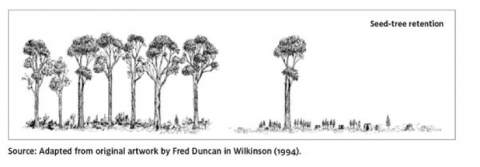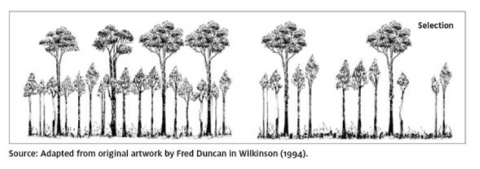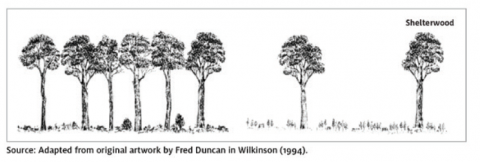Australia’s forests and forestry glossary
Savanna
A tropical or subtropical, woodland/grassland ecosystem in which trees are sufficiently widely spaced that adjacent tree crowns are not in contact. Typically, rainfall is seasonal, and dry-season fires are frequent.
In the National Forest Inventory, areas of savanna where crown cover reaches or exceeds 20% are classified as woodland forest, whereas areas of savanna where crown cover does not reach 20% are classified as non-forest (and, more specifically, as 'Sparse woody vegetation').
See Crown cover, Forest, National Forest Inventory, Sparse woody vegetation, Woodland forest.
Sawlog
Log used to manufacture sawn timber. High-quality sawlogs are sawlogs meeting specified size and grade specifications (including the amount of permissible defect). Low-quality sawlogs are sawlogs not meeting high-quality sawlog specifications.
See Sawn timber.
Sawmill
A wood-processing facility in which logs are sawn by specialised machinery into timber such as boards.
See Sawlog.
Sawn timber
Timber produced by sawing logs into particular sizes. Also known as sawnwood.
Sclerophyll
A description of plants or vegetation that have leaves that are tough, hard or short, such as eucalypts and acacias, and are adapted to dry or nutrient-poor conditions.
See Dry forest/dry sclerophyll forest, Wet forest/wet sclerophyll forest.
Seed orchard
A stand of trees planted and managed specifically for the production of genetically superior seeds.
Seed tree
A tree left standing in a harvested area for the purpose of providing seed for natural regeneration.
Seed-tree silviculture
A native forest silvicultural system in which trees are retained in a harvested area to provide seed for natural regeneration.
See Harvesting, Regeneration, Seed tree, Silvicultural system.

Click here for an enlarged version.
Seedling
A young tree growing from a seed, before it begins to grow branches, increase in height, and become a sapling.
See Sapling.
Selection harvesting
A native forest silvicultural system in which trees (typically those of a specified size or growth stage) are removed singly or in groups, while other trees (such as regrowth, saplings, pole stems or habitat trees) are retained. Generally used in uneven-aged stands.
See Group selection, Harvesting, Sapling, Silvicultural system, Single-tree/small group selection, Uneven-aged forest.

Click here for an enlarged version.
Senescent
1. A native forest growth stage older than mature, when irregular crowns form (sometimes referred to as ‘over-mature’).
2. A native forest growth stage at various ages after 80 years since disturbance. One of four growth stages used at the national level to describe the age of trees and stands of trees.
See Disturbance, Growth stage, Mature, Regeneration, Regrowth.
Shelterwood
A native forest silvicultural system of securing natural tree regeneration under a partially harvested overstorey, which is subsequently removed by subsequent harvest(s) to allow seedlings and young regeneration to occupy the site.
See Harvesting, Overstorey, Regeneration, Seedling, Silvicultural system.

Click here for an enlarged version.
Shrubland
A non-forest vegetation type dominated by woody plants that are single-stemmed or multi-stemmed. Shrubland above 2 metres tall and containing a tree component can also be classified as ‘Sparse woody vegetation’.
Siltation
Deposition of silt (fine soil and mineral matter), usually related to the degradation of watercourses due to soil erosion.
Silvicultural system
A method used in managing forest establishment, composition, growth, harvesting and regeneration.
Also known as a silvicultural practice.
See Aggregated retention, Clearfelling, Group selection, Harvesting, Regeneration, Seed-tree silviculture, Selection harvesting, Shelterwood, Silviculture, Single tree/small group selection, Variable retention.
Silviculture
The art, science and technology of managing forests to achieve specified forest management objectives.
Single tree/small group selection
A native forest silvicultural system in which single trees or small groups of trees of various ages are harvested. This method is suitable for promoting regeneration of shade-tolerant species, or growth of preferred species or individual trees.
See Harvesting, Regeneration, Selection harvesting, Silvicultural system.
Skeletal soils
Shallow soils, usually on ridges or steep slopes.
Slash
Tree debris (e.g. branches, bark) left on site following harvesting events.
See Harvesting.
Snig track
A track along which logs are pulled (snigged) or conveyed from the place where the tree is felled to a nearby log landing or point of loading; also known as an extraction track.
See Log landing.
Softwood
Soil compaction
A reduction in soil volume without loss of soil, leading to poor soil aeration, reduced drainage, and impeded root development.
Soil degradation
Lowering the current and/or future capacity of the soil to support existing forest vegetation and ecosystems.
Soil erodibility
The susceptibility of soil to erosion as a result of soil properties.
Soil erosion hazard
The susceptibility of soil to erosion, combining soil properties, site and climate factors, and management practices. Site factors can include slope, aspect, vegetation and drainage.
Soil moisture regime
The spatial distribution and annual variation in water availability in a soil profile.
Sparse woody vegetation
A non-forest vegetation type of open woodland, heathland or shrubland, generally containing a tree component with actual or potential tree height greater than 2 metres, but either tree crown cover of 5-20%, or cover of trees less than 5% but combined cover shrubs and trees greater than 10%.
Previously known as 'Other woody vegetation'.
See Crown cover, Heathland, Shrubland.
Species
1. A taxonomic rank underneath genus.
2. A biological classification comprising related organisms that share similar characteristics derived from a common gene pool, and that breed to produce fertile offspring.
See Genus, Subspecies, Taxon.
Species diversity
The variety of species in an ecosystem.
SPOT (Satellite Pour l’Observation de la Terre)
A commercial satellite with a high-resolution geometric multi-spectral scanning radiometer providing optical imaging information of the Earth’s entire surface. SPOT data provide information on vegetation cover and vegetation change (e.g. after fire).
Stand
A contiguous area within a forest that contains a cohort of trees that have a common set of characteristics. Normally a stand will be described or managed as a single unit.
Standing volume
The volume (excluding branches) above stump height of living or dead standing trees above a certain size in an area of forest at a given time. Differs from growing stock in including standing dead trees.
State forest
General term for public forest managed by state governments for multiple purposes, including the production and harvesting of wood. Most State forest is included in the National Forest Inventory tenure class ‘Multiple-use public forest’.
See Multiple-use public forest, National Forest Inventory, Publicly managed forest.
Stocking
The density of an area of a forest stand measured as the number of trees, tree basal area or wood volume per unit area, or as the proportion of crown closure. Can apply to stocking of retained trees after harvesting, or to the adequacy of seedling regeneration or planted stock.
See Basal area, Harvesting, Regeneration, Stand.
Stumpage
The price that a private firm pays a landowner for the right to harvest wood from that land.
See Royalties.
Subtropical forest
Forests found in regions located between tropical and temperate zones.
Sustainable development
Development that meets current needs without compromising the ability of future generations to meet their own needs.
Sustainable forest management (SFM)
1. A set of objectives, activities and outcomes consistent with maintaining or improving a forest’s ecological integrity and contributing to people’s wellbeing now and in the future.
2. The practice of stewardship and use of forests and forest lands in such a way, and at a rate, that maintains their biodiversity, productivity, regeneration capacity and vitality, and their potential to fulfil, now and in the future, relevant ecological, economic and social functions at local, national and global levels, and that does not cause damage to other ecosystems.
See Ecologically sustainable forest management (ESFM), Ecosystem, Productivity, Regeneration.
Sustainable yield
The yield of products (e.g. wood, water) from an area of forest that ensures that the functioning of the forest ecosystem as a whole is maintained and the flow of products can continue indefinitely under a given management strategy and suite of sustainable-use objectives.
See Ecosystem.
Sustained yield
In regards to wood, the yield that a forest area can produce continuously at a given intensity of management without impairment of the productivity of the land for a given period of time.
See Productivity.
Taxon
Any taxonomic unit in the classification of plants and animals (e.g. a subspecies, species or genus). Plural: taxa.
See Genus, Species, Subspecies.
Temperate forest
Forests found in the warmer regions of the northern and southern hemisphere but outside the subtropical and tropical zones, characterised by high levels of precipitation and humidity. Comprises warm-temperate and cool-temperate forests.
Tenure
Title to land as controlled by legislation.
See Land tenure.
Thinning
The removal of some trees from a forest stand. Trees remaining after a thinning operation generally grow more rapidly.
See Silvicultural system.
Threat
A natural, human-induced or human-exacerbated factor or process that increases the risk to a species of population reduction or extinction, or that creates a significant risk to the persistence or integrity of an ecological community, or that impairs the ecosystem services or functioning of a particular area or site.
Threatened ecological community
An ecological community listed in any one of the following categories defined in the Commonwealth Environment Protection and Biodiversity Conservation Act 1999: Critically endangered, Endangered or Vulnerable.
See Critically endangered species/ecological community, Ecological community, Endangered species/ecological community, Vulnerable species/ecological community.
Threatened species
A species of native flora or fauna listed in any one of the following categories defined in the Commonwealth Environment Protection and Biodiversity Conservation Act 1999: Extinct, Extinct in the wild, Critically endangered, Endangered or Vulnerable.
See Critically endangered species/ecological community, Endangered species/ecological community, Extinct, Extinct in the wild, Vulnerable species/ecological community.
Threatening process
A natural, human-induced or human-exacerbated process that increases the risk to a species of population reduction or extinction, or is a significant risk to the persistence or integrity of an ecological community. Can be identified as a historical, current or future threat in listing or conservation advice of a threatened ecological community or species.
